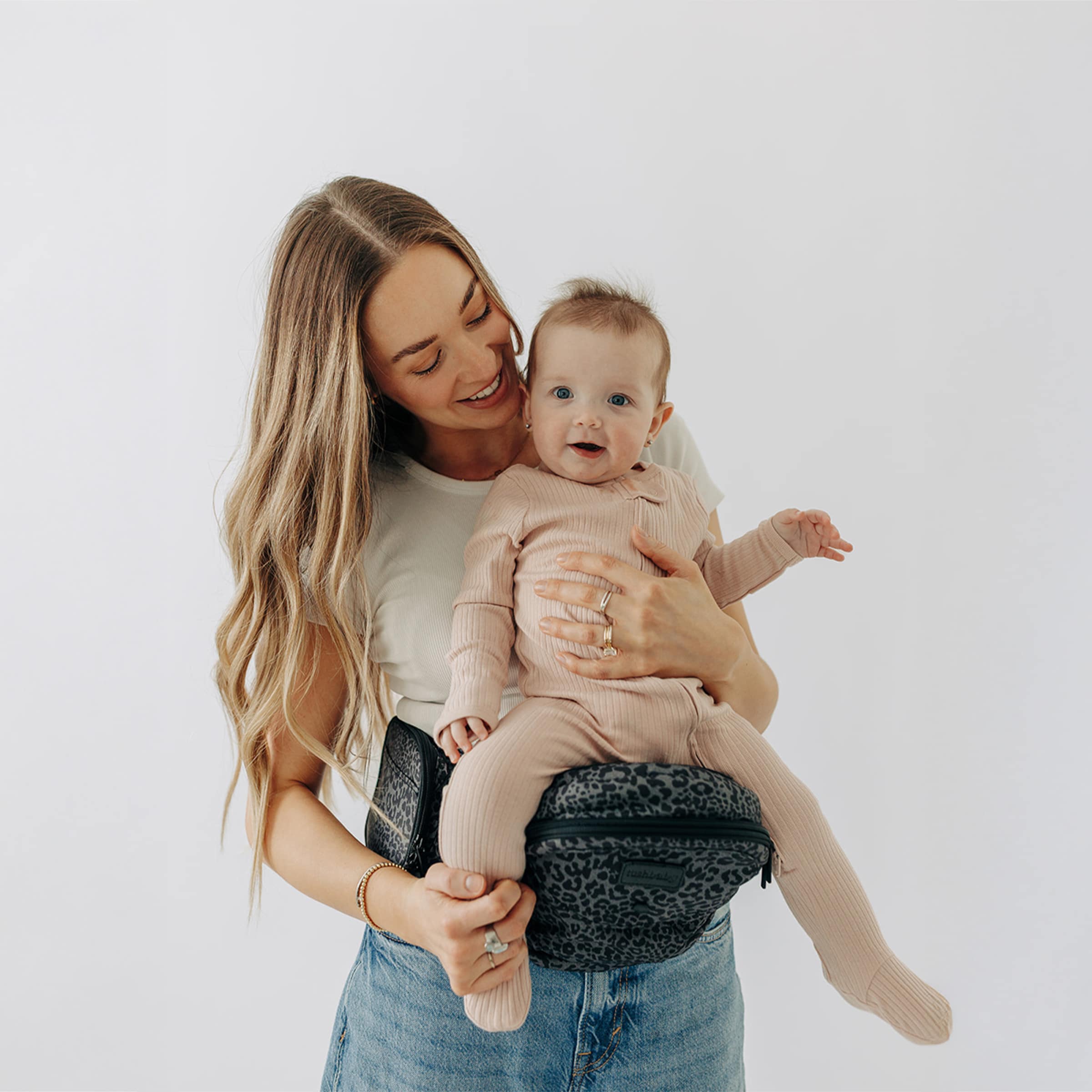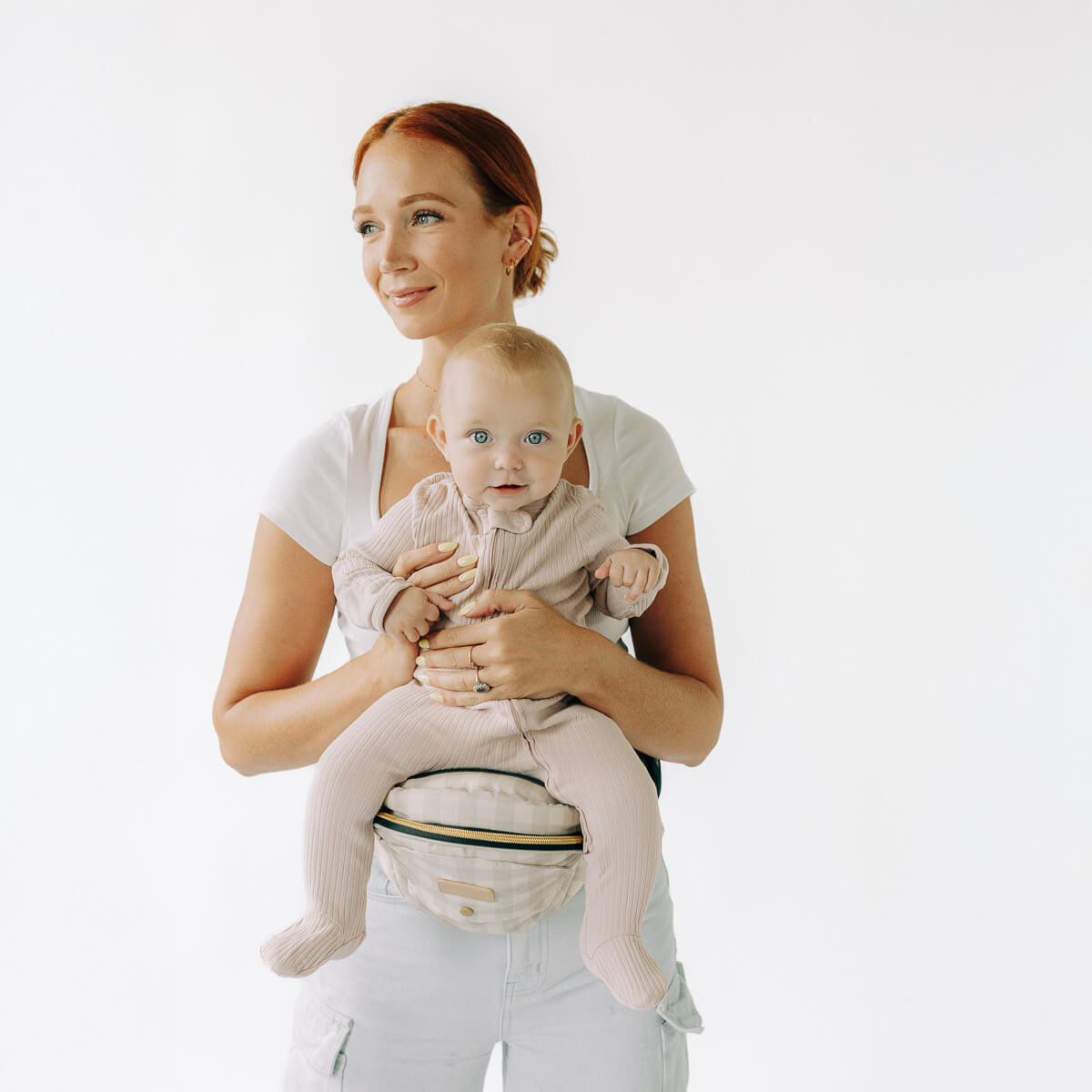How to Get a Toddler to Sleep: Tips for Parents
Written by Katy Arnold on February 07, 2025.
When it comes to toddler sleep training, it can feel like you're negotiating with a tiny, unreasonable boss. If your toddler won’t sleep, rest assured—you’re not alone in the bedtime battlefield.
From stalling tactics to spontaneous 9 PM dance parties, toddlers know how to keep the night interesting. But with a few clever tips and a solid plan, you can turn bedtime chaos into sweet dreams for everyone. Let’s get into it.
Table of Contents
- Toddler Sleep Schedule and Bedtime Routine
- How Much Sleep Does My Toddler Need?
- Toddler Sleep Training
- Why Does My Toddler Wake Up at Night?
- Toddler Teeth Grinding in Sleep
- Toddler Twitching in Sleep
- Sleep Hygiene for Kids
- FAQs
Toddler Sleep Schedule and Bedtime Routine
Building a toddler sleep schedule can feel like solving a puzzle, but a consistent bedtime routine is the secret sauce. Whether you’re juggling a 12-month-old, 14-month-old, or a feisty 2-year-old, knowing what works at each stage can make bedtime smoother (and dare we say, enjoyable).
Here’s a breakdown to keep your little one well-rested:
12-Month-Old Sleep Schedule
-
Naps: 2 naps a day, about 1.5-2 hours each.
-
Bedtime: Aim for around 7:00 PM. Keep the routine simple: bath, book, and bed.
-
Total Sleep: 12-14 hours daily (because tiny humans grow fast).
14-Month-Old Sleep Schedule
-
Naps: Transitioning to 1-2 naps. If you’re sticking to 2, shorten the morning nap.
-
Bedtime: Stick to 7:00 PM for consistency. Wind-down time is key here.
-
Total Sleep: 12-13 hours daily, still enough to fuel those first steps.
2-Year-Old Sleep Schedule
-
Naps: 1 nap, 1-2 hours long.
-
Bedtime: 7:30 PM works well for most toddlers—though they might try negotiating for “one more story.”
-
Total Sleep: 11-12 hours daily—because being two is exhausting.
The magic is in the routine. Keep it predictable, calm, and focused on connection so your toddler knows sleep isn’t the enemy.
How Much Sleep Does My Toddler Need?
How many hours of sleep do kids need? Toddlers typically thrive on 11–14 hours of sleep in a 24-hour period, split between nighttime slumbers and daytime snoozes.
But when do toddlers stop napping? Most drop their last nap between 3-5 years old, though some overachievers give it up earlier. Until then, naps and consistent bedtimes are your best tools to keep your toddler well-rested—and less likely to have a meltdown.
Toddler Sleep Training
Toddler sleep training can feel like trying to tame a tiny, determined night owl—but it doesn’t have to be a nightly showdown. We’re here to share tips to help you turn bedtime chaos into calm, one sleepy step at a time.
Tips to Get Your Toddler to Sleep
Let’s break down how to sleep train a toddler:
-
Consistency is key: Start with a routine of bath, books, bed—then repeat. This consistent schedule signals to your toddler that it’s time to wind down.
-
Stay calm and stick to the plan: Even if your toddler protests, keep the bedtime vibes low-drama and soothing.
-
Ease bedtime cuddles: Use the Tushbaby Hip Carrier to hold your toddler comfortably during those pre-bedtime snuggles. It helps soothe and calm them while saving your back, so you can focus on creating a peaceful wind-down moment before laying them down to sleep.
When it comes to the best sleeping positions for toddlers, the goal is safety and comfort. Most toddlers naturally find their sweet spot, whether it’s on their back, side, or tummy.
Back sleeping is generally recommended for safety, but if your toddler rolls onto their tummy or side during the night, it’s usually fine by this age. If you want to learn more about baby sleeping positions, read our guide here.
Why Does My Toddler Wake Up at Night?
Sleep disruptions in toddlers are common, whether it’s from teething, developmental milestones, or a newfound fear of the dark. To tackle the age-old question, how to get my toddler to sleep through the night, start with a solid bedtime routine—one that’s consistent, calming, and free of screen time before bed.
If your toddler won't sleep, check for underlying culprits like hunger, discomfort, or even a nap schedule that needs tweaking. Remember, patience is key—both for your toddler and your own sanity.
Toddler Teeth Grinding in Sleep
Ever heard a weird grinding noise at night and realized it’s coming from your toddler’s tiny jaws? Yep, toddler grinding teeth in sleep is a thing, and while it sounds unsettling, it’s often no big deal.
This condition, called bruxism, can be triggered by teething, stress, or even their body’s attempt to align their bite as their jaw grows. If this has you worried, keep an eye out for signs of discomfort or mention it at their next dentist appointment.
Toddler Twitching in Sleep
If your little one looks like they’re practicing dance moves while snoozing, you’re probably witnessing your toddler twitching in sleep—and it’s totally normal. These jerky movements, called sleep myoclonus, often happen as their busy brain transitions through sleep cycles. It’s like their nervous system’s version of a nightly “system check.”
While it might look a bit odd, it’s rarely a cause for concern. If the twitches seem extreme or disrupt their sleep, it’s worth chatting with your pediatrician, but most of the time, it’s just another quirky phase of toddlerhood.
Sleep Hygiene for Kids
Sleep hygiene for kids doesn’t have to be complicated—just a few simple tweaks can make bedtime smoother for everyone. Here’s how:
-
Stick to a consistent bedtime: Kids thrive on routines, so keep it predictable.
-
Create a sleep-friendly environment: Cool, dark, and quiet is the secret recipe.
-
Cut off screen time early: Blue light before bed keeps little brains buzzing—save it for the daytime.
-
Add a calming activity: Reading, singing, or gentle stretches can help wind them down.
-
Use a pacifier to soothe: Pacifiers can work wonders for helping kids self-soothe. Keep one handy and clean with The Pod by Tushbaby—a sleek, stylish pouch that clips to your carrier or bag for easy access.
-
Keep it predictable: Repeating the same steps nightly sets the stage for better sleep (and less bedtime drama).
FAQs
When Can Toddlers Sleep With a Blanket?
Toddlers can safely start sleeping with a blanket around 12 months, once they’re able to move freely and pull it away from their face. Lightweight, toddler-sized blankets are best to keep things safe and comfy.
Until then, sleep sacks are a great option—they’re basically a cozy blanket toddlers can’t kick off, so everyone gets a better night’s sleep.
How Do I Stop My Toddler from Having Separation Anxiety at Night?
The key to dealing with toddler separation anxiety at sleep time is to create a comforting bedtime routine that helps them feel secure. Spend quality time together before lights out, and when it’s time to leave the room, keep your goodnight quick and consistent, even if they call you back (which they will). A nightlight or special stuffed animal can also offer extra reassurance.
When Can Toddlers Sleep With a Pillow?
Toddlers don’t need a pillow until they’re around 18-24 months, and even then, it’s about keeping it simple—a flat, toddler-sized pillow is plenty. Until they’re ready, their crib or bed is already designed to support them just fine.
Toddler sleep training can feel like a marathon, but with consistency, patience, and a little creativity, you’ll cross the finish line to peaceful nights.
Make bedtime (and all the moments in between) easier with smart solutions from Tushbaby—shop now to simplify your parenting journey.


![Tushbaby photo - Women holding baby using tushbaby gray ::[15109665390658]](http://tushbaby.com/cdn/shop/files/GreyCarrier.webp?v=1762198155)
![Tushbaby photo - Women holding baby using tushbaby gray ::[15109665390658]](http://tushbaby.com/cdn/shop/files/Grey3.webp?v=1748543102)
![Tushbaby photo - Women holding baby using tushbaby gray ::[15109665390658]](http://tushbaby.com/cdn/shop/files/rKeAfN6W.webp?v=1748543102)
![Tushbaby photo - Women holding baby using tushbaby gray ::[15109665390658]](http://tushbaby.com/cdn/shop/files/Grey4_95ede319-844c-41db-96eb-608ec6a3b897.webp?v=1748543102)
![Tushbaby photo - Women holding baby using tushbaby gray ::[15109665390658]](http://tushbaby.com/cdn/shop/files/Grey2.webp?v=1748543102)
![Tushbaby photo - Women holding baby using tushbaby gray ::[15109665390658]](http://tushbaby.com/cdn/shop/files/Grey5.webp?v=1747418215)
![Tushbaby photo - Hip seat carrier,baby carrier hip seat,baby wrap carrier baby carrier wrap,baby carrier,baby wrap carriers,baby carriers,baby wraps,baby sling wrap,baby slings,baby wrap sling,carrier for big baby, toddler carrier, nursing carrier, breastfeeding carrier, diaper bag, baby belt carrier, strapless carrier, big kid carrier, special needs carrier,Tote,Diaper bag,Tote bag,Diaper pad,Changing pad,Pacifier pod,Coin purse,Vegan leather bag,Vegan tote,Vegan baby products,plus sized baby carrier::[15109665390658]](http://tushbaby.com/cdn/shop/files/Grey8.webp?v=1747418215)
![Tushbaby photo - Tushbaby grey holding bottle ::[15109665390658]](http://tushbaby.com/cdn/shop/files/Grey9.webp?v=1747418215)
![Tushbaby photo - Women using tushbaby::[15109665423426]](http://tushbaby.com/cdn/shop/files/BlackColor1.webp?v=1747418215)
![Tushbaby photo - man using tushbaby::[15109665423426]](http://tushbaby.com/cdn/shop/files/BlackColor2.webp?v=1747418215)
![Tushbaby photo - Women using tushbaby::[15109665423426]](http://tushbaby.com/cdn/shop/files/BlackColor3.webp?v=1747418215)
![Tushbaby photo - ::[15109665423426]](http://tushbaby.com/cdn/shop/files/BlackColor4.webp?v=1747418215)
![Tushbaby photo - ::[15109665423426]](http://tushbaby.com/cdn/shop/files/BlackColor5.webp?v=1747418215)
![Tushbaby photo - ::[15109665423426]](http://tushbaby.com/cdn/shop/files/BlackColor6.webp?v=1747418215)
![Tushbaby photo - ::[15109665423426]](http://tushbaby.com/cdn/shop/files/BlackColor7.webp?v=1747418215)
![Tushbaby photo - ::[15109665423426]](http://tushbaby.com/cdn/shop/files/BlackColor9.webp?v=1747418215)
![Tushbaby photo - Women using tushbaby::[15109665521730]](http://tushbaby.com/cdn/shop/files/Black_Gold1_3.webp?v=1747418215)
![Tushbaby photo - Women using tushbaby::[15109665521730]](http://tushbaby.com/cdn/shop/files/Black_Gold2.webp?v=1747418215)
![Tushbaby photo - Women using tushbaby::[15109665521730]](http://tushbaby.com/cdn/shop/files/Black_Gold3.webp?v=1747418215)
![Tushbaby photo - Women using tushbaby::[15109665521730]](http://tushbaby.com/cdn/shop/files/Black_Gold4.webp?v=1747418215)
![Tushbaby photo - Man using tushbaby::[15109665521730]](http://tushbaby.com/cdn/shop/files/Black_Gold5.webp?v=1747418215)
![Tushbaby photo - Women using tushbaby::[15109665521730]](http://tushbaby.com/cdn/shop/files/Black_Gold6.webp?v=1747418215)
![Tushbaby photo - Tushbaby::[15109665521730]](http://tushbaby.com/cdn/shop/files/Black_Gold7.webp?v=1747418215)
![Tushbaby photo - Tushbaby::[15109665521730]](http://tushbaby.com/cdn/shop/files/Black_Gold9.webp?v=1747418215)
![Tushbaby photo - ::[31311822422082]](http://tushbaby.com/cdn/shop/files/VeganLeatherBlack1.webp?v=1747418215)
![Tushbaby photo - ::[31311822422082]](http://tushbaby.com/cdn/shop/files/VeganLeatherBlack3.webp?v=1747418215)
![Tushbaby photo - ::[31311822422082]](http://tushbaby.com/cdn/shop/files/VeganLeatherBlack4.webp?v=1747418215)
![Tushbaby photo - ::[31311822422082]](http://tushbaby.com/cdn/shop/files/VeganLeatherBlack5.webp?v=1747418215)
![Tushbaby photo - ::[31311822422082]](http://tushbaby.com/cdn/shop/files/VeganLeatherBlack7.webp?v=1747418215)
![Tushbaby photo - ::[31311822422082]](http://tushbaby.com/cdn/shop/files/VeganLeatherBlack8.webp?v=1747418215)
![Tushbaby photo - ::[31311822422082]](http://tushbaby.com/cdn/shop/files/VeganLeatherBlack9.webp?v=1747418215)
![Tushbaby photo - ::[40092713287746]](http://tushbaby.com/cdn/shop/files/LiteCharcoal1.webp?v=1747418215)
![Tushbaby photo - ::[40092713287746]](http://tushbaby.com/cdn/shop/files/LiteCharcoal2.webp?v=1747418215)
![Tushbaby photo - ::[40092713287746]](http://tushbaby.com/cdn/shop/files/LiteCharcoal3.webp?v=1747418215)
![Tushbaby photo - ::[40092713287746]](http://tushbaby.com/cdn/shop/files/LiteCharcoal4.webp?v=1747418215)
![Tushbaby photo - ::[40092713287746]](http://tushbaby.com/cdn/shop/files/LiteCharcoal6.webp?v=1747418215)
![Tushbaby photo - ::[40092713287746]](http://tushbaby.com/cdn/shop/files/LiteCharcoal7.webp?v=1747418215)
![Tushbaby photo - ::[40092713287746]](http://tushbaby.com/cdn/shop/files/LiteCharcoal8.webp?v=1747418215)
![Tushbaby photo - ::[40092713320514]](http://tushbaby.com/cdn/shop/files/VelvetSable1.webp?v=1747418215)
![Tushbaby photo - ::[40092713320514]](http://tushbaby.com/cdn/shop/files/VelvetSable3.webp?v=1747418215)
![Tushbaby photo - ::[40092713320514]](http://tushbaby.com/cdn/shop/files/VelvetSable4.webp?v=1747418215)
![Tushbaby photo - ::[40092713320514]](http://tushbaby.com/cdn/shop/files/VelvetSable5.webp?v=1747418215)
![Tushbaby photo - ::[40092713320514]](http://tushbaby.com/cdn/shop/files/VelvetSable6.webp?v=1747418215)
![Tushbaby photo - ::[40092713320514]](http://tushbaby.com/cdn/shop/files/VelvetSable7.webp?v=1747418215)
![Tushbaby photo - ::[40092713320514]](http://tushbaby.com/cdn/shop/files/VelvetSable8.webp?v=1747418215)
![Tushbaby photo - ::[40288698040386]](http://tushbaby.com/cdn/shop/files/VeganLeatherCognac1.webp?v=1747418215)
![Tushbaby photo - ::[40288698040386]](http://tushbaby.com/cdn/shop/files/VeganLeatherCognac3.webp?v=1747418215)
![Tushbaby photo - ::[40288698040386]](http://tushbaby.com/cdn/shop/files/VeganLeatherCognac4.webp?v=1747418215)
![Tushbaby photo - ::[40288698040386]](http://tushbaby.com/cdn/shop/files/VeganLeatherCognac5.webp?v=1747418215)
![Tushbaby photo - ::[40288698040386]](http://tushbaby.com/cdn/shop/files/VeganLeatherCognac6.webp?v=1747418215)
![Tushbaby photo - ::[40288698040386]](http://tushbaby.com/cdn/shop/files/VeganLeatherCognac7.webp?v=1747418215)
![Tushbaby photo - ::[40288698040386]](http://tushbaby.com/cdn/shop/files/VeganLeatherCognac8.webp?v=1747418215)
![Tushbaby photo - ::[40288698040386]](http://tushbaby.com/cdn/shop/files/VeganLeatherCognac9.webp?v=1747418215)
![Tushbaby photo - ::[40288698040386]](http://tushbaby.com/cdn/shop/files/VeganLeatherCognac10.webp?v=1747418215)
![Tushbaby photo - ::[40503457382466]](http://tushbaby.com/cdn/shop/files/Orchid1Square.webp?v=1747418215)
![Tushbaby photo - ::[40503457382466]](http://tushbaby.com/cdn/shop/files/Orchid3Square.webp?v=1747418215)
![Tushbaby photo - ::[40503457382466]](http://tushbaby.com/cdn/shop/files/Orchid4Square.webp?v=1747418215)
![Tushbaby photo - ::[40503457382466]](http://tushbaby.com/cdn/shop/files/Orchid5Square.webp?v=1747418215)
![Tushbaby photo - ::[40503457382466]](http://tushbaby.com/cdn/shop/files/Orchid6Square.webp?v=1747418215)
![Tushbaby photo - ::[40503457382466]](http://tushbaby.com/cdn/shop/files/Orchid7Square.webp?v=1747418215)
![Tushbaby photo - ::[40503457382466]](http://tushbaby.com/cdn/shop/files/Orchid8Square.webp?v=1747418215)
![Tushbaby photo - ::[40503457382466]](http://tushbaby.com/cdn/shop/files/Orchid9Square.webp?v=1747418215)
![Tushbaby photo - ::[40503457382466]](http://tushbaby.com/cdn/shop/files/Orchid10Square.webp?v=1747418215)
![Tushbaby photo - ::[40288993017922]](http://tushbaby.com/cdn/shop/files/VeganLeatherCream1.webp?v=1747418215)
![Tushbaby photo - ::[40288993017922]](http://tushbaby.com/cdn/shop/files/VeganLeatherCream3.webp?v=1747418215)
![Tushbaby photo - ::[40288993017922]](http://tushbaby.com/cdn/shop/files/VeganLeatherCream4.webp?v=1747418215)
![Tushbaby photo - ::[40288993017922]](http://tushbaby.com/cdn/shop/files/VeganLeatherCream6.webp?v=1747418215)
![Tushbaby photo - ::[40288993017922]](http://tushbaby.com/cdn/shop/files/TBcream_blackseat2.jpg?v=1759513482)
![Tushbaby photo - ::[40288993017922]](http://tushbaby.com/cdn/shop/files/VeganLeatherCream7.webp?v=1759513482)
![Tushbaby photo - ::[40288993017922]](http://tushbaby.com/cdn/shop/files/VeganLeatherCream9.webp?v=1759513482)
![Tushbaby photo - ::[40503457415234]](http://tushbaby.com/cdn/shop/files/SnowLeopard1.webp?v=1759513482)
![Tushbaby photo - ::[40288993017922]](http://tushbaby.com/cdn/shop/files/TBcream_blackseat1_b994af6f-4e75-4f7b-b8ba-9750798bd0e7.jpg?v=1759513482)
![Tushbaby photo - ::[40503457415234]](http://tushbaby.com/cdn/shop/files/SnowLeopard3.webp?v=1759513482)
![Tushbaby photo - ::[40503457415234]](http://tushbaby.com/cdn/shop/files/SnowLeopard4.webp?v=1759513482)
![Tushbaby photo - ::[40503457415234]](http://tushbaby.com/cdn/shop/files/SnowLeopard5.webp?v=1759513482)
![Tushbaby photo - ::[40503457415234]](http://tushbaby.com/cdn/shop/files/SnowLeopard6.webp?v=1759513482)
![Tushbaby photo - ::[40503457415234]](http://tushbaby.com/cdn/shop/files/SnowLeopard7.webp?v=1759513482)
![Tushbaby photo - ::[40503457415234]](http://tushbaby.com/cdn/shop/files/SnowLeopard8.webp?v=1759513482)
![Tushbaby photo - ::[40503457415234]](http://tushbaby.com/cdn/shop/files/SnowLeopard9.webp?v=1759513482)
![Tushbaby photo - ::[40503457448002]](http://tushbaby.com/cdn/shop/files/Tweed1.-Square.webp?v=1759513482)
![Tushbaby photo - ::[40503457448002]](http://tushbaby.com/cdn/shop/files/Tweed3-Square.webp?v=1759513482)
![Tushbaby photo - ::[40503457448002]](http://tushbaby.com/cdn/shop/files/Tweed4-Square.webp?v=1759513482)
![Tushbaby photo - ::[40503457448002]](http://tushbaby.com/cdn/shop/files/Tweed5-Square.webp?v=1759513482)
![Tushbaby photo - ::[40503457448002]](http://tushbaby.com/cdn/shop/files/Tweed6-Square.webp?v=1759513482)
![Tushbaby photo - ::[40503457448002]](http://tushbaby.com/cdn/shop/files/Tweed8-Square.webp?v=1759513482)
![Tushbaby photo - ::[41633540800578]](http://tushbaby.com/cdn/shop/files/Marble1.webp?v=1759513482)
![Tushbaby photo - ::[41633540800578]](http://tushbaby.com/cdn/shop/files/Marble2.webp?v=1759513482)
![Tushbaby photo - ::[41633540800578]](http://tushbaby.com/cdn/shop/files/Marble4.webp?v=1759513482)
![Tushbaby photo - ::[41633540800578]](http://tushbaby.com/cdn/shop/files/Marble5.webp?v=1759513482)
![Tushbaby photo - ::[41633540800578]](http://tushbaby.com/cdn/shop/files/Marble6.webp?v=1759513482)
![Tushbaby photo - ::[41633540800578]](http://tushbaby.com/cdn/shop/files/Marble7.webp?v=1759513482)
![Tushbaby photo - ::[41633540800578]](http://tushbaby.com/cdn/shop/files/Marble8.webp?v=1759513482)
![Tushbaby photo - ::[41633540800578]](http://tushbaby.com/cdn/shop/files/Marble9.webp?v=1759513482)
![Tushbaby photo - ::[41984257556546]](http://tushbaby.com/cdn/shop/files/Olive1_297431f9-eeb3-411c-bc0e-08d37e703197.webp?v=1759513482)
![Tushbaby photo - ::[41984257556546]](http://tushbaby.com/cdn/shop/files/Olive2_bb6953ff-d61f-471a-b48f-3b36c7dbfb21.webp?v=1759513482)
![Tushbaby photo - ::[41984257556546]](http://tushbaby.com/cdn/shop/files/Olive3_97f99469-33f5-4192-9446-dcdfdbf32e84.webp?v=1759513482)
![Tushbaby photo - ::[41984257556546]](http://tushbaby.com/cdn/shop/files/Olive4_f9c88ddf-96de-476c-bef3-d57f9ddbd5c1.webp?v=1759513482)
![Tushbaby photo - ::[41984257556546]](http://tushbaby.com/cdn/shop/files/Olive5_e2741f35-99ec-4ed5-9307-809ef4ead286.webp?v=1759513482)
![Tushbaby photo - ::[41984257556546]](http://tushbaby.com/cdn/shop/files/Olive6_a66205d9-b767-4224-a04f-6e20597c7c38.webp?v=1759513482)
![Tushbaby photo - ::[41984257556546]](http://tushbaby.com/cdn/shop/files/Olive7_ab97dc70-f0b9-4a70-9137-943b8e3982e1.webp?v=1759513482)
![Tushbaby photo - ::[41984257556546]](http://tushbaby.com/cdn/shop/files/Olive8.webp?v=1759513482)
![Tushbaby photo - ::[41984257556546]](http://tushbaby.com/cdn/shop/files/Olive9.webp?v=1759513482)

![Tushbaby photo - ::[s-uper-image] ::[e-mbroidery]](http://tushbaby.com/cdn/shop/files/BlackLeather-Monogram1.webp?v=1759513482)
![Tushbaby photo - ::[s-uper-image] ::[e-mbroidery]](http://tushbaby.com/cdn/shop/files/Orchid-Monogram.webp?v=1759513482)







































![Tushbaby photo - Women holding baby using tushbaby gray ::[15109665390658]](http://tushbaby.com/cdn/shop/files/GreyCarrier_160x.webp?v=1762198155)
![Tushbaby photo - Women holding baby using tushbaby gray ::[15109665390658]](http://tushbaby.com/cdn/shop/files/Grey3_160x.webp?v=1748543102)
![Tushbaby photo - Women holding baby using tushbaby gray ::[15109665390658]](http://tushbaby.com/cdn/shop/files/rKeAfN6W_160x.webp?v=1748543102)
![Tushbaby photo - Women holding baby using tushbaby gray ::[15109665390658]](http://tushbaby.com/cdn/shop/files/Grey4_95ede319-844c-41db-96eb-608ec6a3b897_160x.webp?v=1748543102)
![Tushbaby photo - Women holding baby using tushbaby gray ::[15109665390658]](http://tushbaby.com/cdn/shop/files/Grey2_160x.webp?v=1748543102)
![Tushbaby photo - Women holding baby using tushbaby gray ::[15109665390658]](http://tushbaby.com/cdn/shop/files/Grey5_160x.webp?v=1747418215)
![Tushbaby photo - Hip seat carrier,baby carrier hip seat,baby wrap carrier baby carrier wrap,baby carrier,baby wrap carriers,baby carriers,baby wraps,baby sling wrap,baby slings,baby wrap sling,carrier for big baby, toddler carrier, nursing carrier, breastfeeding carrier, diaper bag, baby belt carrier, strapless carrier, big kid carrier, special needs carrier,Tote,Diaper bag,Tote bag,Diaper pad,Changing pad,Pacifier pod,Coin purse,Vegan leather bag,Vegan tote,Vegan baby products,plus sized baby carrier::[15109665390658]](http://tushbaby.com/cdn/shop/files/Grey8_160x.webp?v=1747418215)
![Tushbaby photo - Tushbaby grey holding bottle ::[15109665390658]](http://tushbaby.com/cdn/shop/files/Grey9_160x.webp?v=1747418215)
![Tushbaby photo - Women using tushbaby::[15109665423426]](http://tushbaby.com/cdn/shop/files/BlackColor1_160x.webp?v=1747418215)
![Tushbaby photo - man using tushbaby::[15109665423426]](http://tushbaby.com/cdn/shop/files/BlackColor2_160x.webp?v=1747418215)
![Tushbaby photo - Women using tushbaby::[15109665423426]](http://tushbaby.com/cdn/shop/files/BlackColor3_160x.webp?v=1747418215)
![Tushbaby photo - ::[15109665423426]](http://tushbaby.com/cdn/shop/files/BlackColor4_160x.webp?v=1747418215)
![Tushbaby photo - ::[15109665423426]](http://tushbaby.com/cdn/shop/files/BlackColor5_160x.webp?v=1747418215)
![Tushbaby photo - ::[15109665423426]](http://tushbaby.com/cdn/shop/files/BlackColor6_160x.webp?v=1747418215)
![Tushbaby photo - ::[15109665423426]](http://tushbaby.com/cdn/shop/files/BlackColor7_160x.webp?v=1747418215)
![Tushbaby photo - ::[15109665423426]](http://tushbaby.com/cdn/shop/files/BlackColor9_160x.webp?v=1747418215)
![Tushbaby photo - Women using tushbaby::[15109665521730]](http://tushbaby.com/cdn/shop/files/Black_Gold1_3_160x.webp?v=1747418215)
![Tushbaby photo - Women using tushbaby::[15109665521730]](http://tushbaby.com/cdn/shop/files/Black_Gold2_160x.webp?v=1747418215)
![Tushbaby photo - Women using tushbaby::[15109665521730]](http://tushbaby.com/cdn/shop/files/Black_Gold3_160x.webp?v=1747418215)
![Tushbaby photo - Women using tushbaby::[15109665521730]](http://tushbaby.com/cdn/shop/files/Black_Gold4_160x.webp?v=1747418215)
![Tushbaby photo - Man using tushbaby::[15109665521730]](http://tushbaby.com/cdn/shop/files/Black_Gold5_160x.webp?v=1747418215)
![Tushbaby photo - Women using tushbaby::[15109665521730]](http://tushbaby.com/cdn/shop/files/Black_Gold6_160x.webp?v=1747418215)
![Tushbaby photo - Tushbaby::[15109665521730]](http://tushbaby.com/cdn/shop/files/Black_Gold7_160x.webp?v=1747418215)
![Tushbaby photo - Tushbaby::[15109665521730]](http://tushbaby.com/cdn/shop/files/Black_Gold9_160x.webp?v=1747418215)
![Tushbaby photo - ::[31311822422082]](http://tushbaby.com/cdn/shop/files/VeganLeatherBlack1_160x.webp?v=1747418215)
![Tushbaby photo - ::[31311822422082]](http://tushbaby.com/cdn/shop/files/VeganLeatherBlack3_160x.webp?v=1747418215)
![Tushbaby photo - ::[31311822422082]](http://tushbaby.com/cdn/shop/files/VeganLeatherBlack4_160x.webp?v=1747418215)
![Tushbaby photo - ::[31311822422082]](http://tushbaby.com/cdn/shop/files/VeganLeatherBlack5_160x.webp?v=1747418215)
![Tushbaby photo - ::[31311822422082]](http://tushbaby.com/cdn/shop/files/VeganLeatherBlack7_160x.webp?v=1747418215)
![Tushbaby photo - ::[31311822422082]](http://tushbaby.com/cdn/shop/files/VeganLeatherBlack8_160x.webp?v=1747418215)
![Tushbaby photo - ::[31311822422082]](http://tushbaby.com/cdn/shop/files/VeganLeatherBlack9_160x.webp?v=1747418215)
![Tushbaby photo - ::[40092713287746]](http://tushbaby.com/cdn/shop/files/LiteCharcoal1_160x.webp?v=1747418215)
![Tushbaby photo - ::[40092713287746]](http://tushbaby.com/cdn/shop/files/LiteCharcoal2_160x.webp?v=1747418215)
![Tushbaby photo - ::[40092713287746]](http://tushbaby.com/cdn/shop/files/LiteCharcoal3_160x.webp?v=1747418215)
![Tushbaby photo - ::[40092713287746]](http://tushbaby.com/cdn/shop/files/LiteCharcoal4_160x.webp?v=1747418215)
![Tushbaby photo - ::[40092713287746]](http://tushbaby.com/cdn/shop/files/LiteCharcoal6_160x.webp?v=1747418215)
![Tushbaby photo - ::[40092713287746]](http://tushbaby.com/cdn/shop/files/LiteCharcoal7_160x.webp?v=1747418215)
![Tushbaby photo - ::[40092713287746]](http://tushbaby.com/cdn/shop/files/LiteCharcoal8_160x.webp?v=1747418215)
![Tushbaby photo - ::[40092713320514]](http://tushbaby.com/cdn/shop/files/VelvetSable1_160x.webp?v=1747418215)
![Tushbaby photo - ::[40092713320514]](http://tushbaby.com/cdn/shop/files/VelvetSable3_160x.webp?v=1747418215)
![Tushbaby photo - ::[40092713320514]](http://tushbaby.com/cdn/shop/files/VelvetSable4_160x.webp?v=1747418215)
![Tushbaby photo - ::[40092713320514]](http://tushbaby.com/cdn/shop/files/VelvetSable5_160x.webp?v=1747418215)
![Tushbaby photo - ::[40092713320514]](http://tushbaby.com/cdn/shop/files/VelvetSable6_160x.webp?v=1747418215)
![Tushbaby photo - ::[40092713320514]](http://tushbaby.com/cdn/shop/files/VelvetSable7_160x.webp?v=1747418215)
![Tushbaby photo - ::[40092713320514]](http://tushbaby.com/cdn/shop/files/VelvetSable8_160x.webp?v=1747418215)
![Tushbaby photo - ::[40288698040386]](http://tushbaby.com/cdn/shop/files/VeganLeatherCognac1_160x.webp?v=1747418215)
![Tushbaby photo - ::[40288698040386]](http://tushbaby.com/cdn/shop/files/VeganLeatherCognac3_160x.webp?v=1747418215)
![Tushbaby photo - ::[40288698040386]](http://tushbaby.com/cdn/shop/files/VeganLeatherCognac4_160x.webp?v=1747418215)
![Tushbaby photo - ::[40288698040386]](http://tushbaby.com/cdn/shop/files/VeganLeatherCognac5_160x.webp?v=1747418215)
![Tushbaby photo - ::[40288698040386]](http://tushbaby.com/cdn/shop/files/VeganLeatherCognac6_160x.webp?v=1747418215)
![Tushbaby photo - ::[40288698040386]](http://tushbaby.com/cdn/shop/files/VeganLeatherCognac7_160x.webp?v=1747418215)
![Tushbaby photo - ::[40288698040386]](http://tushbaby.com/cdn/shop/files/VeganLeatherCognac8_160x.webp?v=1747418215)
![Tushbaby photo - ::[40288698040386]](http://tushbaby.com/cdn/shop/files/VeganLeatherCognac9_160x.webp?v=1747418215)
![Tushbaby photo - ::[40288698040386]](http://tushbaby.com/cdn/shop/files/VeganLeatherCognac10_160x.webp?v=1747418215)
![Tushbaby photo - ::[40503457382466]](http://tushbaby.com/cdn/shop/files/Orchid1Square_160x.webp?v=1747418215)
![Tushbaby photo - ::[40503457382466]](http://tushbaby.com/cdn/shop/files/Orchid3Square_160x.webp?v=1747418215)
![Tushbaby photo - ::[40503457382466]](http://tushbaby.com/cdn/shop/files/Orchid4Square_160x.webp?v=1747418215)
![Tushbaby photo - ::[40503457382466]](http://tushbaby.com/cdn/shop/files/Orchid5Square_160x.webp?v=1747418215)
![Tushbaby photo - ::[40503457382466]](http://tushbaby.com/cdn/shop/files/Orchid6Square_160x.webp?v=1747418215)
![Tushbaby photo - ::[40503457382466]](http://tushbaby.com/cdn/shop/files/Orchid7Square_160x.webp?v=1747418215)
![Tushbaby photo - ::[40503457382466]](http://tushbaby.com/cdn/shop/files/Orchid8Square_160x.webp?v=1747418215)
![Tushbaby photo - ::[40503457382466]](http://tushbaby.com/cdn/shop/files/Orchid9Square_160x.webp?v=1747418215)
![Tushbaby photo - ::[40503457382466]](http://tushbaby.com/cdn/shop/files/Orchid10Square_160x.webp?v=1747418215)
![Tushbaby photo - ::[40288993017922]](http://tushbaby.com/cdn/shop/files/VeganLeatherCream1_160x.webp?v=1747418215)
![Tushbaby photo - ::[40288993017922]](http://tushbaby.com/cdn/shop/files/VeganLeatherCream3_160x.webp?v=1747418215)
![Tushbaby photo - ::[40288993017922]](http://tushbaby.com/cdn/shop/files/VeganLeatherCream4_160x.webp?v=1747418215)
![Tushbaby photo - ::[40288993017922]](http://tushbaby.com/cdn/shop/files/VeganLeatherCream6_160x.webp?v=1747418215)
![Tushbaby photo - ::[40288993017922]](http://tushbaby.com/cdn/shop/files/TBcream_blackseat2_160x.jpg?v=1759513482)
![Tushbaby photo - ::[40288993017922]](http://tushbaby.com/cdn/shop/files/VeganLeatherCream7_160x.webp?v=1759513482)
![Tushbaby photo - ::[40288993017922]](http://tushbaby.com/cdn/shop/files/VeganLeatherCream9_160x.webp?v=1759513482)
![Tushbaby photo - ::[40503457415234]](http://tushbaby.com/cdn/shop/files/SnowLeopard1_160x.webp?v=1759513482)
![Tushbaby photo - ::[40288993017922]](http://tushbaby.com/cdn/shop/files/TBcream_blackseat1_b994af6f-4e75-4f7b-b8ba-9750798bd0e7_160x.jpg?v=1759513482)
![Tushbaby photo - ::[40503457415234]](http://tushbaby.com/cdn/shop/files/SnowLeopard3_160x.webp?v=1759513482)
![Tushbaby photo - ::[40503457415234]](http://tushbaby.com/cdn/shop/files/SnowLeopard4_160x.webp?v=1759513482)
![Tushbaby photo - ::[40503457415234]](http://tushbaby.com/cdn/shop/files/SnowLeopard5_160x.webp?v=1759513482)
![Tushbaby photo - ::[40503457415234]](http://tushbaby.com/cdn/shop/files/SnowLeopard6_160x.webp?v=1759513482)
![Tushbaby photo - ::[40503457415234]](http://tushbaby.com/cdn/shop/files/SnowLeopard7_160x.webp?v=1759513482)
![Tushbaby photo - ::[40503457415234]](http://tushbaby.com/cdn/shop/files/SnowLeopard8_160x.webp?v=1759513482)
![Tushbaby photo - ::[40503457415234]](http://tushbaby.com/cdn/shop/files/SnowLeopard9_160x.webp?v=1759513482)
![Tushbaby photo - ::[40503457448002]](http://tushbaby.com/cdn/shop/files/Tweed1.-Square_160x.webp?v=1759513482)
![Tushbaby photo - ::[40503457448002]](http://tushbaby.com/cdn/shop/files/Tweed3-Square_160x.webp?v=1759513482)
![Tushbaby photo - ::[40503457448002]](http://tushbaby.com/cdn/shop/files/Tweed4-Square_160x.webp?v=1759513482)
![Tushbaby photo - ::[40503457448002]](http://tushbaby.com/cdn/shop/files/Tweed5-Square_160x.webp?v=1759513482)
![Tushbaby photo - ::[40503457448002]](http://tushbaby.com/cdn/shop/files/Tweed6-Square_160x.webp?v=1759513482)
![Tushbaby photo - ::[40503457448002]](http://tushbaby.com/cdn/shop/files/Tweed8-Square_160x.webp?v=1759513482)
![Tushbaby photo - ::[41633540800578]](http://tushbaby.com/cdn/shop/files/Marble1_160x.webp?v=1759513482)
![Tushbaby photo - ::[41633540800578]](http://tushbaby.com/cdn/shop/files/Marble2_160x.webp?v=1759513482)
![Tushbaby photo - ::[41633540800578]](http://tushbaby.com/cdn/shop/files/Marble4_160x.webp?v=1759513482)
![Tushbaby photo - ::[41633540800578]](http://tushbaby.com/cdn/shop/files/Marble5_160x.webp?v=1759513482)
![Tushbaby photo - ::[41633540800578]](http://tushbaby.com/cdn/shop/files/Marble6_160x.webp?v=1759513482)
![Tushbaby photo - ::[41633540800578]](http://tushbaby.com/cdn/shop/files/Marble7_160x.webp?v=1759513482)
![Tushbaby photo - ::[41633540800578]](http://tushbaby.com/cdn/shop/files/Marble8_160x.webp?v=1759513482)
![Tushbaby photo - ::[41633540800578]](http://tushbaby.com/cdn/shop/files/Marble9_160x.webp?v=1759513482)
![Tushbaby photo - ::[41984257556546]](http://tushbaby.com/cdn/shop/files/Olive1_297431f9-eeb3-411c-bc0e-08d37e703197_160x.webp?v=1759513482)
![Tushbaby photo - ::[41984257556546]](http://tushbaby.com/cdn/shop/files/Olive2_bb6953ff-d61f-471a-b48f-3b36c7dbfb21_160x.webp?v=1759513482)
![Tushbaby photo - ::[41984257556546]](http://tushbaby.com/cdn/shop/files/Olive3_97f99469-33f5-4192-9446-dcdfdbf32e84_160x.webp?v=1759513482)
![Tushbaby photo - ::[41984257556546]](http://tushbaby.com/cdn/shop/files/Olive4_f9c88ddf-96de-476c-bef3-d57f9ddbd5c1_160x.webp?v=1759513482)
![Tushbaby photo - ::[41984257556546]](http://tushbaby.com/cdn/shop/files/Olive5_e2741f35-99ec-4ed5-9307-809ef4ead286_160x.webp?v=1759513482)
![Tushbaby photo - ::[41984257556546]](http://tushbaby.com/cdn/shop/files/Olive6_a66205d9-b767-4224-a04f-6e20597c7c38_160x.webp?v=1759513482)
![Tushbaby photo - ::[41984257556546]](http://tushbaby.com/cdn/shop/files/Olive7_ab97dc70-f0b9-4a70-9137-943b8e3982e1_160x.webp?v=1759513482)
![Tushbaby photo - ::[41984257556546]](http://tushbaby.com/cdn/shop/files/Olive8_160x.webp?v=1759513482)
![Tushbaby photo - ::[41984257556546]](http://tushbaby.com/cdn/shop/files/Olive9_160x.webp?v=1759513482)

![Tushbaby photo - ::[s-uper-image] ::[e-mbroidery]](http://tushbaby.com/cdn/shop/files/BlackLeather-Monogram1_160x.webp?v=1759513482)
![Tushbaby photo - ::[s-uper-image] ::[e-mbroidery]](http://tushbaby.com/cdn/shop/files/Orchid-Monogram_160x.webp?v=1759513482)














































Leave a comment